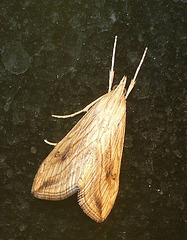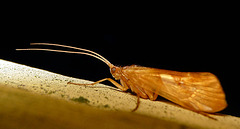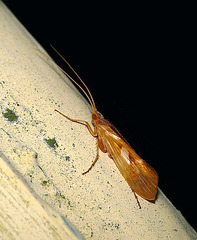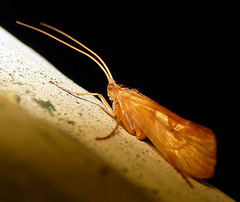C.Rayz's photos with the keyword: batch 1027
Amblyptilia Acanthadactyla
Early Thorn
| 10 Aug 2009 |
|
Again not early really, second brood so markings are a bit faded but a nice example.
Single-dotted Wave
Limnephilus rhombicus -Caddis Fly 5
| 10 Aug 2009 |
|
I can't seem to find much information on this insect, so if anyone has a site or a place I can find out which Caddis this is, let me know.
We thought this was a moth, and that's often the case with this Caddis Fly, they are related in prehistoric times with the moths, most are in larval stages in water. Most build cases to live in during that stage and to pupate in. They only live a very short time as adults, about a week max. They emerge much like a dragonfly does from the water, spread their tiny wings and fly away. They can be attracted to light and apparently make excellent bait bugs, since most of the information I found on them was from 'fishing tackle type' sites.
Looking at the Global Biodiversity Information Facility site suggests there hasn't been any documented in Hastings since 1945, I'm not entirely sure that's the case, but it is very difficult to get any information on the 198 species that can/have been found in the UK.
Garden Pebble
| 10 Aug 2009 |
|
Limnephilus rhombicus -Caddis Fly 4
| 10 Aug 2009 |
|
I can't seem to find much information on this insect, so if anyone has a site or a place I can find out which Caddis this is, let me know.
We thought this was a moth, and that's often the case with this Caddis Fly, they are related in prehistoric times with the moths, most are in larval stages in water. Most build cases to live in during that stage and to pupate in. They only live a very short time as adults, about a week max. They emerge much like a dragonfly does from the water, spread their tiny wings and fly away. They can be attracted to light and apparently make excellent bait bugs, since most of the information I found on them was from 'fishing tackle type' sites.
Looking at the Global Biodiversity Information Facility site suggests there hasn't been any documented in Hastings since 1945, I'm not entirely sure that's the case, but it is very difficult to get any information on the 198 species that can/have been found in the UK.
The Engrailed
Caddis Fly 2
| 10 Aug 2009 |
|
I can't seem to find much information on this insect, so if anyone has a site or a place I can find out which Caddis this is, let me know.
We thought this was a moth, and that's often the case with this Caddis Fly, they are related in prehistoric times with the moths, most are in larval stages in water. Most build cases to live in during that stage and to pupate in. They only live a very short time as adults, about a week max. They emerge much like a dragonfly does from the water, spread their tiny wings and fly away. They can be attracted to light and apparently make excellent bait bugs, since most of the information I found on them was from 'fishing tackle type' sites.
Looking at the Global Biodiversity Information Facility site suggests there hasn't been any documented in Hastings since 1945, I'm not entirely sure that's the case, but it is very difficult to get any information on the 198 species that can/have been found in the UK.
Limnephilus rhombicus -Caddis Fly 3
| 10 Aug 2009 |
|
I can't seem to find much information on this insect, so if anyone has a site or a place I can find out which Caddis this is, let me know.
We thought this was a moth, and that's often the case with this Caddis Fly, they are related in prehistoric times with the moths, most are in larval stages in water. Most build cases to live in during that stage and to pupate in. They only live a very short time as adults, about a week max. They emerge much like a dragonfly does from the water, spread their tiny wings and fly away. They can be attracted to light and apparently make excellent bait bugs, since most of the information I found on them was from 'fishing tackle type' sites.
Looking at the Global Biodiversity Information Facility site suggests there hasn't been any documented in Hastings since 1945, I'm not entirely sure that's the case, but it is very difficult to get any information on the 198 species that can/have been found in the UK.
Limnephilus rhombicus -Caddis Fly 1
| 10 Aug 2009 |
|
I can't seem to find much information on this insect, so if anyone has a site or a place I can find out which Caddis this is, let me know.
We thought this was a moth, and that's often the case with this Caddis Fly, they are related in prehistoric times with the moths, most are in larval stages in water. Most build cases to live in during that stage and to pupate in. They only live a very short time as adults, about a week max. They emerge much like a dragonfly does from the water, spread their tiny wings and fly away. They can be attracted to light and apparently make excellent bait bugs, since most of the information I found on them was from 'fishing tackle type' sites.
Looking at the Global Biodiversity Information Facility site suggests there hasn't been any documented in Hastings since 1945, I'm not entirely sure that's the case, but it is very difficult to get any information on the 198 species that can/have been found in the UK.
Jump to top
RSS feed- C.Rayz's latest photos with "batch 1027" - Photos
- ipernity © 2007-2025
- Help & Contact
|
Club news
|
About ipernity
|
History |
ipernity Club & Prices |
Guide of good conduct
Donate | Group guidelines | Privacy policy | Terms of use | Statutes | In memoria -
Facebook
Twitter










